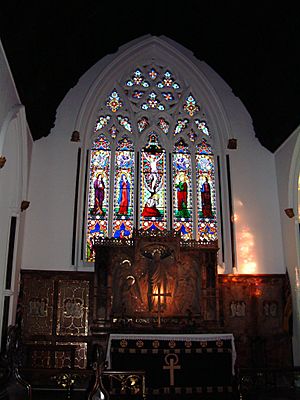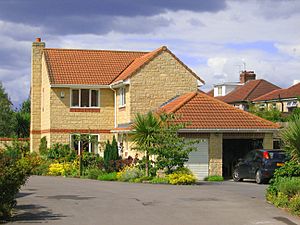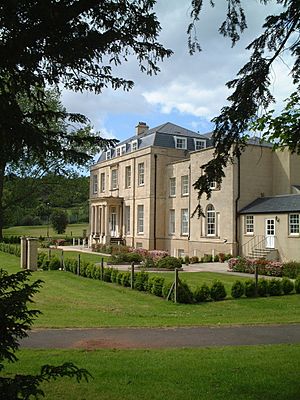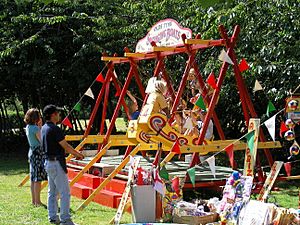Stapleton, Bristol facts for kids
Quick facts for kids Stapleton |
|
|---|---|
 Bell Hill and the spire of Church of Holy Trinity |
|
| OS grid reference | ST615758 |
| Unitary authority | |
| Ceremonial county | |
| Region | |
| Country | England |
| Sovereign state | United Kingdom |
| Post town | BRISTOL |
| Postcode district | BS |
| Dialling code | 0117 |
| Police | Avon and Somerset |
| Fire | Avon |
| Ambulance | Great Western |
| EU Parliament | South West England |
| UK Parliament |
|
Stapleton is an area in the northeastern part of Bristol, England. The name often describes the long village along Bell Hill and Park Road in the Frome Valley. It borders Eastville to the south and Begbrook and Frenchay to the north. You can find many different types of houses here, mostly from the Victorian, Edwardian, and 20th-century periods.
Stapleton is a popular place to live for a few reasons. It is close to the M32 motorway, which gives quick access to the M4 and M5. It also feels like a countryside area, even though it is only two miles from central Bristol. Plus, it has a well-known private school.
Stapleton's church is a famous landmark in Bristol. You can see its spire from the M32 motorway as cars drive past.
Contents
What's in a Name?
The name "Stapleton" comes from old English words. "Stapol" means "post," and "ton" means "settlement." In the past, a "staple town" was a special place where certain goods had to be brought to be sold. This system helped governments tax trade.
Stapleton's Past
The old area of Stapleton included Fishponds and Eastville. It was once part of Kingswood Forest. The Saxon village of Stapleton was first written about in 1208. It was located near the River Frome. Roman coins found here show that people lived in this area even earlier. Even in the 1700s, Stapleton was still very wooded.
In 1174, the village was given to Tewkesbury Abbey. Later, by the late 1500s, it belonged to the Berkeley family. It then passed to the Duke of Beaufort, who owned the land until 1917.
In 1781, the common land in Stapleton was divided up and sold. Most of it went to the Duke of Beaufort. Stapleton, which was then in Gloucestershire, became a civil parish in 1866. However, on April 1, 1898, it became part of Bristol. In 1891, the area had a population of 14,589 people.
Mining History
Coal was an important industry here. By 1700, there were about 70 coal pits. Many local men worked in these mines throughout the 1700s. In the 1890s, the mines produced a thousand tons of coal every day.
Famous People from Stapleton
Several notable people have connections to Stapleton. Frances Milton, the mother of the famous writer Anthony Trollope, was born here in 1780. Sarah Young, the mother of poet Thomas Chatterton, was also born in the village.
The Indian social reformer Ram Mohan Roy died at Beech House in 1833. He was cared for by Mary Carpenter, the daughter of Lant Carpenter, who lived there.
The village grew steadily over time. In 1871, there were 6,960 people living here. By 1901, the population had grown to 21,236.
Sports in Stapleton
A cricket club started in Stapleton in 1863. Its most famous player was Dr. William Gilbert Grace. He played for Gloucestershire and the England team.
A football team called the Black Arabs started at Purdown. This team later became Bristol Rovers. Purdown is also known for a local legend. Some say it is haunted by the ghost of a Duchess of Beaufort. People believe she was struck by lightning or died in a horse riding accident.
Getting Around Stapleton
In the 1800s, two Great Western Railway lines were built through the area. They met at Stapleton Road railway station, which opened in 1863. Tramways were also built. At first, horses pulled the trams, but later they became electric. Electric trams reached Fishponds in 1897.
The village of Stapleton is on the B4058 road. However, the M32 motorway now bypasses it to the west and north. Junction 2 of this motorway is just south of the village. This junction provides easy access to the M4 and M5 motorways. These motorways connect Stapleton to places like Cardiff and Newport in South Wales, London, and Birmingham.
In 2022, some bus services changed. The number 5 bus was replaced, and the Y4 bus was removed. As a result, the area now has no bus service.
Important Buildings
Stapleton Church
Church History
There has been a church on this site for at least 500 years. The first church was dedicated to St. Giles. Between 1691 and 1720, the old church was taken down. A new one, dedicated to the Holy Trinity, was built in its place.
In 1854, Bishop Monk offered to rebuild the church at his own cost. He wanted to stop arguments over pews and make sure there was enough seating for everyone. The Chancel part of the church was rebuilt by Greville Smyth. The new church was dedicated on April 15, 1857. The Choir Vestry was added in 1892.
The Church Building
The church is a beautiful example of Victorian Gothic architecture. It was built using Pennant stone from local quarries. The decorative stone came from quarries near Bath.
Outside the Church
The Tower and its spire are very tall, reaching 170 feet high. The tower has strong supports and decorative tops. These stand next to the spire, which has carvings and a large metal cross at the very top. At the bottom of the Tower is a beautifully carved West Doorway.
Inside the Church
Inside, you can see fine carvings of heads, angels, and leaves. These decorate the arches, roof supports, and window tops. The entire roof is made of oak wood. The roof in the chancel area is especially detailed with ribs and carvings.
Font
The font, used for baptisms, dates from 1857. It is made of alabaster and stands on marble pillars. The oak cover is a memorial to two members of the Hall family who died in the First World War.
Pulpit
The pulpit, where sermons are given, seems to have been made for another church. It has carvings of Christ, St Peter, and St Paul.
Lectern
A beautiful brass eagle lectern was given in memory of Charles Castle, who died in 1886.
Choir Stalls
The choir stalls are special because of their finely carved leaves and kneeling angels.
Reredos
This decorative screen behind the altar was given in 1907. It shows Jesus holding out his hands, with angels standing or kneeling beside him.
Organ
The church has a two-manual organ built by Vowles of Bristol in 1873. It has 21 speaking stops and uses electro-pneumatic action.
Lady Chapel
The oak reredos and communion rail in the Lady Chapel were given in memory of Lt. Fitzroy Charles Phillpotts, who died in 1915.
Stained Glass Windows
Each window in the church has a unique design. They show different Bible stories and figures. For example:
- West Window: Shows Bishop Monk offering a model of the church to Christ.
- North Aisle: Features scenes like Jesus blessing children and the women at the empty tomb.
- East Window: The main window shows the Crucifixion, with smaller scenes below it.
- Lady Chapel (East): Shows the Adoration of the Magi. This window was damaged in World War II and repaired in 1949.
Memorials
There are several memorials inside the church. Over the North Door, there is a memorial to the Walter family. Other tablets on the walls remember people like the Revd. Henry Shute.
Bells
The church has a set of six bells. Some of these bells are very old, with one dating back to 1669. Others were added or recast later.
Old Font
The square font in the West porch is very old, from about the year 1000. When the second church was taken down, this font was sold. It was used as a flower pot at a local inn! Later, it was found and returned to the church. It has marks showing where a cover was once fitted to prevent people from misusing the holy water.
Recent Updates
- 1987: Gas central heating was installed. A toilet was added, and an access ramp was built for easier entry.
- 1993: The electric lighting was updated, and new floodlighting was added for the spire.
Other Important Buildings
The church of St Thomas the Apostle in Eastville was built in 1889. It is now a Pentecostal hall.
Stapleton is also home to Collegiate School, a private school for both boys and girls. It used to be called Colston's School. The school moved to Stapleton in 1861. It took over a site that was once the Bishop's Palace. This building is now a Grade II listed building. It was originally called Stapleton House and became the Bishop of Bristol and Gloucester's home in 1840.
Further north, you can find the Masonic Hall, which is home to the Filton Chapter of Freemasons.
In the mid-1990s, a large housing development was built on the site of an old hospital. This area, called Glendale Grange, added over 150 new homes. These homes range from small two-bedroom houses to larger 4 and 5-bedroom villas. The development also included renovating Beech House (a former estate owner's home) and Linden House (a former farmhouse) into new homes.
This development also created a new village green for Stapleton. It has a play park for younger children. The green is a central spot for many village events, like summer fairs and Christmas carol concerts.
This part of the village also has New Friends Hall, which is part of the North Bristol NHS Trust. Across the motorway, there is Heath House Hospital, part of the Priory Group.
On the hilltop north of the Priory buildings, on Purdown, stands the Purdown BT Tower. This is one of twelve reinforced concrete towers owned by BT in the UK. It is mainly used for sending microwave signals. You can walk on public footpaths around the tower, crossing the M32 motorway via a bridge.
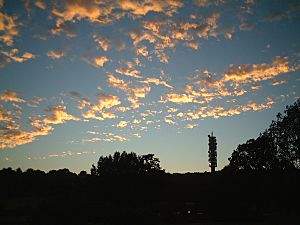
Who Lives in Stapleton?
In 2010, many families lived in Stapleton. Many residents work in the local area or in Greater Bristol. A lot of them have technical jobs at the University of the West of England, the Ministry of Defence, and Hewlett-Packard. These workplaces are all within five kilometers of the village center. Stapleton is becoming a more popular place to live because it's easy to get to the city and major employers. This has led to house prices going up.



